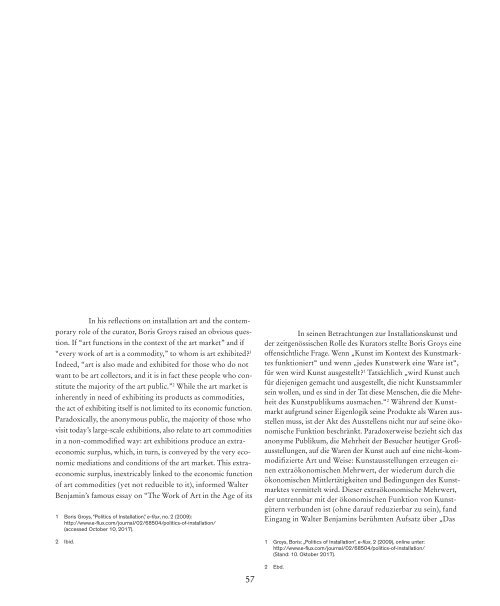Exhibiting Matters
ISBN 978-3-86859-854-4
ISBN 978-3-86859-854-4
You also want an ePaper? Increase the reach of your titles
YUMPU automatically turns print PDFs into web optimized ePapers that Google loves.
In his reflections on installation art and the contemporary<br />
role of the curator, Boris Groys raised an obvious question.<br />
If “art functions in the context of the art market” and if<br />
“every work of art is a commodity,” to whom is art exhibited? 1<br />
Indeed, “art is also made and exhibited for those who do not<br />
want to be art collectors, and it is in fact these people who constitute<br />
the majority of the art public.” 2 While the art market is<br />
inherently in need of exhibiting its products as commodities,<br />
the act of exhibiting itself is not limited to its economic function.<br />
Paradoxically, the anonymous public, the majority of those who<br />
visit today’s large-scale exhibitions, also relate to art commodities<br />
in a non-commodified way: art exhibitions produce an extraeconomic<br />
surplus, which, in turn, is conveyed by the very economic<br />
mediations and conditions of the art market. This extraeconomic<br />
surplus, inextricably linked to the economic function<br />
of art commodities (yet not reducible to it), informed Walter<br />
Benjamin’s famous essay on “The Work of Art in the Age of its<br />
1 Boris Groys, “Politics of Installation,” e-flux, no. 2 (2009):<br />
http://www.e-flux.com/journal/02/68504/politics-of-installation/<br />
(accessed October 10, 2017).<br />
2 Ibid.<br />
57<br />
In seinen Betrachtungen zur Installationskunst und<br />
der zeitgenössischen Rolle des Kurators stellte Boris Groys eine<br />
offensichtliche Frage. Wenn „Kunst im Kontext des Kunstmarktes<br />
funktioniert“ und wenn „jedes Kunstwerk eine Ware ist“,<br />
für wen wird Kunst ausgestellt? 1 Tatsächlich „wird Kunst auch<br />
für diejenigen gemacht und ausgestellt, die nicht Kunstsammler<br />
sein wollen, und es sind in der Tat diese Menschen, die die Mehrheit<br />
des Kunstpublikums ausmachen.“ 2 Während der Kunstmarkt<br />
aufgrund seiner Eigenlogik seine Produkte als Waren ausstellen<br />
muss, ist der Akt des Ausstellens nicht nur auf seine ökonomische<br />
Funktion beschränkt. Paradoxerweise bezieht sich das<br />
anonyme Publikum, die Mehrheit der Besucher heutiger Großausstellungen,<br />
auf die Waren der Kunst auch auf eine nicht-kommodifizierte<br />
Art und Weise: Kunstausstellungen erzeugen einen<br />
extraökonomischen Mehrwert, der wiederum durch die<br />
ökonomischen Mittlertätigkeiten und Bedingungen des Kunstmarktes<br />
vermittelt wird. Dieser extraökonomische Mehrwert,<br />
der untrennbar mit der ökonomischen Funktion von Kunstgütern<br />
verbunden ist (ohne darauf reduzierbar zu sein), fand<br />
Eingang in Walter Benjamins berühmten Aufsatz über „Das<br />
1 Groys, Boris: ‚Politics of Installation“, e-flux, 2 (2009), online unter:<br />
http://www.e-flux.com/journal/02/68504/politics-of-installation/<br />
(Stand: 10. Oktober 2017).<br />
2 Ebd.


















